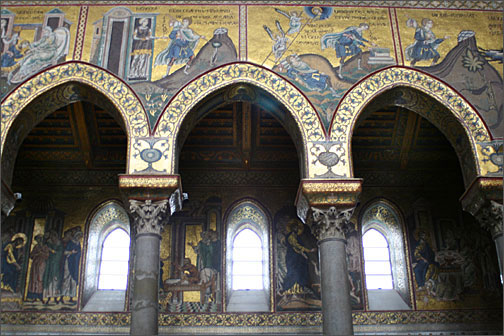Monreale, Sicily
Dear Reader,
I
have never been shy about saying that one of my life's ambitions is to see every
art museum in the world. Some people think that's nuts, but today I can happily
add one more iconic art locale to my journal: the Monreale Cathedral, about 5
miles outside of Palermo.
How did it make it to my list of "must sees"?
Whenever I read about ANY PLACE, my radar seeks these words: art museum, wonders
of the art world, destination for art lovers. If the article or book convinces
me that the place is trip-worthy, I grab my pen and add it to my already bulging
lineup.
Admittedly, my first impulse to visit Sicily was to set foot in
the village that was my grandparents' birthplace. Who knew that I would actually
meet my second cousins and experience one of the most thrilling days of my life?
But, that's another story. Who knew that Mt. Etna would be so impressive? But,
that's another story. Who knew that Monreale would fulfill every aspect of this
art lover's dream? That is this story.
What is Monreale and why is it a
destination for so many artists and art historians? Think Byzantine mosaics and
be prepared to use the words "glittering," "shimmering," and
"mesmerizing" without embarrassment. Are there other Byzantine mosaics
I remember? Yes, those in Rome's Basilica of Saint Praxedes stunned me because
I could stand in a tiny side chapel and be nose-to-nose with their beauty. Yes,
in Istanbul, the Museum of Chora's mosaics and frescoes were intimately accessible.
Monreale
earns its "cathedral" status due to its size, and its sheer immensity
is overwhelming. Almost every inch is covered with mosaics: ceilings, walls, columns,
floors. The occasional glowing wood carving is almost a relief.
The challenge
of appreciating Monreale Cathedral was to take in the parts and not to be intimidated
by the whole. That thought helped me to appreciate why it worked so well as an
educational tool for illiterate worshipers. People could read it "like a
comic book" and learn the Bible's stories.
This made me think about
the Sistine Chapel, which tells stories just as grand or iconic, and whose walls
and ceiling are peppered with saints, deities and powerful church dignitaries.
Religious scholars have written about each character in the religious dramas and
portraits that Michelangelo painted there. Monreale Cathedral, on the other hand,
was made so the common people could experience a share of awe-inspiring beauty
and visual texts.
I offer you some information and advice about visiting
Monreale Cathedral, followed by one picture that is worth a thousand words:
---The
cathedral was built in 1172 by William II with a monastery next to it. Make time
to see all of it, even if you have to stand in line.
---Notice the 1179
bronze door by Barisano da Trani, if you can hold off for a few minutes longer
before going inside.
---Once inside, just pick a spot and keep looking.
Pick another spot and keep looking. Stretch your neck, which should be hurting
by now. Pick another spot…
---Take in the mosaic cycle, 12th and 13th
century works that cover the nave and aisles. These are the "comic book"
pages of scenes from the Old and New Testaments.
---Of course, look at the
Christ portrait in the middle apse.
---I fell in love with the stylized
palm trees that lined the aisles. Wondrous patterns! I'll bet that they mean something
more than "I am beautiful. Look at me."
---The cloister has more
mosaics, if you haven't had your fill. You won't, I hope.

